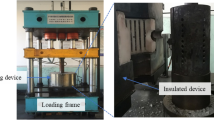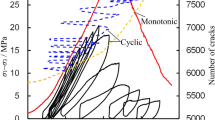Abstract
A series of tests were performed to study the mechanical properties of granite subjected to triaxial cyclic loading–unloading compression under hydro-mechanical coupling. The results show that the damage and permeability evolution of rock are interrelated, and the permeability is closely related to the microfracture propagation during the damage process. The cyclic load magnitude has a controlling effect on the fatigue behavior of the material. When different loading magnitudes are selected, the specimens show different correlation between permeability and residual strain. The correlation analysis between volumetric residual strain and permeability evolution shows that cyclic load not only causes fatigue damage to rock, but also has compaction effect. When confining pressure is larger, the effect of the cyclic load magnitude on the damage will be relatively lower. The linear models of permeability, deformation modulus, radial–axial strain ratio, residual strain, and cyclic load were established to analyze the sensitivity of each parameter to damage. The initial microfractures in granite specimens increase after thermal cycling test, and the P-wave velocity first decreases and then tends to be stable in the whole process. Scanning electron microscope observation shows that more microfractures develop along the axial direction of specimens, which indicates that fatigue damage has directivity.
Highlights
-
The larger the confining pressure, the smaller the influence of cyclic load magnitude on the damage.
-
High-cycle fatigue behavior shows that rock permeability decreases and the compactness increases.


















Similar content being viewed by others
References
Chen YL (2018) Permeability evolution in granite under compressive stress condition. Geotech Geol Eng 36(1):641–647
Figueiredo B, Tsang CF, Rutqvist J, Niemi A (2017) The effects of nearby fractures on hydraulically induced fracture propagation and permeability changes. Eng Geol 228:197–213
Hofmann H, Blocher G, Milsch H, Babadagli T, Zimmermann G (2016) Transmissivity of aligned and displaced tensile fractures in granitic rocks during cyclic loading. Int J Rock Mech Min Sci 87:69–84
Hoshino K (1993) Construction of underground caverns for petroleum storage in orogenic areas—geological stability. Eng Geol 35(3–4):199–205
Ivars DM (2006) Water inflow into excavations in fractured rock—a three-dimensional hydro-mechanical numerical study. Int J Rock Mech Min Sci 43(5):705–725
Jafari M, Pellet F, Boulon M, Hosseini K (2004) Experimental study of mechanical behaviour of rock joints under cyclic loading. Rock Mech Rock Eng 37:3–23
Jiang Y, Li B, Tanabashi Y (2006) Estimating the relation between surface roughness and mechanical properties of rock joints. Int J Rock Mech Min Sci 43(6):837–846
Ju MH, Li XF, Li JC (2021) Large-scale asymmetric pulverisation of fault zone: Insights from rock axial strain in static and dynamic loading conditions. Int J Rock Mech Min Sci 137.
Kong F, Shang J (2018) A validation study for the estimation of uniaxial compressive strength based on index tests. Rock Mech Rock Eng 51(7):2289–2297
Li SC, Wang ZC, Ping Y, Zhou Y, Zhang L (2014) Discrete element analysis of hydro-mechanical behavior of a pilot underground crude oil storage facility in granite in China. Tunn Undergr Space Tech 40:75–84
Li XB, Gong FQ, Tao M, Dong LJ, Du K, Ma CD, Zhou ZL, Yin TB (2017) Failure mechanism and coupled static-dynamic loading theory in deep hard rock mining: a review. J Rock Mech Geotech Eng 9(4):767–782
Li ZQ, Xue YG, Li SC, Qiu DH, Su MX, Zhao Y, Zhou BH (2019) An analytical model for surrounding rock classification during underground water-sealed caverns construction: a case study from eastern China. Environ Earth Sci. https://doi.org/10.1007/s12665-019-8606-4
Li Z, Xue Y, Liang J, Qiu D, Su M, Kong F (2020) Performance assessment of the water curtain system: a monitoring system in an underground water-sealed oil reservoir in China. B Eng Geol Environ. https://doi.org/10.1007/s10064-020-01792-0
Liu EL, He SM (2012) Effects of cyclic dynamic loading on the mechanical properties of intact rock samples under confining pressure conditions. Eng Geol 125:81–91
Liu E, He S, Xue X, Xu J (2011) Dynamic properties of intact rock samples subjected to cyclic loading under confining pressure conditions. Rock Mech Rock Eng 44:629–634
Liu L, Xu WY, Wang HL, Wang W, Wang RB (2016) Permeability evolution of granite gneiss during triaxial creep tests. Rock Mech Rock Eng 49(9):3455–3462
Liu J, Zhao XD, Zhang SJ, Xie LK (2018) Analysis of support requirements for underground water-sealed oil storage cavern in China. Tunn Undergr Space Tech 71:36–46
Ma XD, Haimson BC (2016) Failure characteristics of two porous sandstones subjected to true triaxial stresses. J Geophys Res Solid Earth 121(9):6477–6498
Meng QB, Liu JF, Ren L, Pu H, Chen YL (2020) Experimental study on rock strength and deformation characteristics under triaxial cyclic loading and unloading conditions. Rock Mech Rock Eng 54:777–797
Ning Z, Xue Y, Su M, Qiu D, Zhang K, Li Z, Liu Y (2021) Deformation characteristics observed during multi-step excavation of underground oil storage caverns based on field monitoring and numerical simulation. Environ Earth Sci 80:222
Selvadurai APS, Boulon MJ, Nguyen TS (2005) The permeability of an intact granite. Pure Appl Geophys 162(2):373–407
Shang J, Hencher SR, West LJ (2016) Tensile strength of geological discontinuities including incipient bedding, rock joints and mineral veins. Rock Mech Rock Eng 49(11):4213–4225
Shang J, Hencher SR, West LJ, Handley K (2017) Forensic excavation of rock masses: a technique to investigate discontinuity persistence. Rock Mech Rock Eng 50(11):2911–2928
Sun B, Zhu ZD, Shi C, Luo ZH (2017) Dynamic mechanical behavior and fatigue damage evolution of sandstone under cyclic loading. Int J Rock Mech Min Sci 94:82–89
Ulusay R, Hudson JA (2007) The complete ISRM suggested methods for rock characterization, testing and monitoring, Iskitler, Ankara.
Wang HL, Chu WJ, He M (2012) Anisotropic permeability evolution model of rock in the process of deformation and failure. J Hydrodyn 24(1):25–31
Wang ZC, Li SC, Qiao LP, Zhao JG (2013) Fatigue behavior of granite subjected to cyclic loading under triaxial compression condition. Rock Mech Rock Eng 46(6):1603–1615
Wang ZC, Li SC, Qiao LP (2015) Assessment of hydro-mechanical behavior of a granite rock mass for a pilot underground crude oil storage facility in China. Rock Mech Rock Eng 48(6):2459–2472
Wang Z, Glais Y, Qiao L, Huang A, Liu J (2018) Hydro-geochemical analysis of the interplay between the groundwater, host rock and water curtain system for an underground oil storage facility. Tunn Undergr Sp Tech 71:466–477
Wu YS, Pruess K (2000) Integral solutions for transient fluid flow through a porous medium with pressure-dependent permeability. Int J Rock Mech Min Sci 37(1–2):51–61
Xiao JQ, Ding DX, Jiang FL, Xu G (2010) Fatigue damage variable and evolution of rock subjected to cyclic loading. Int J Rock Mech Min Sci 47(3):461–468
Xu XL, Karakus M (2018) A coupled thermo-mechanical damage model for granite. Int J Rock Mech Min Sci 103:195–204
Xue YG, Li SC, Qiu DH, Wang ZC, Li ZQ, Tian H, Su MX, Yang WM, Lin CJ, Zhu JY (2015) A new evaluation method for site selection of large underground water-sealed petroleum storage depots. Sci China Technol Sci 58(6):967–978
Xue DJ, Zhou HW, Zhao YW, Zhang L, Deng LS, Wang XY (2018) Real-time SEM observation of mesoscale failures under thermal-mechanical coupling sequences in granite. Int J Rock Mech Min Sci 112:35–46
Xue Y, Ning Z, Qiu D, Su M, Li Z, Kong F, Li G, Wang P (2021) A study of water curtain parameters of underground oil storage caverns using time series monitoring and numerical simulation. J Zhejiang Univ Sci A 22(3):165–181
Yang T, Liu HY, Tang CA (2017) Scale effect in macroscopic permeability of jointed rock mass using a coupled stress-damage-flow method. Eng Geol 228:121–136
Yang FJ, Hu DW, Zhou H, Lu JJ (2020) Physico-mechanical behaviors of granite under coupled static and dynamic cyclic loadings. Rock Mech Rock Eng 53(5):2157–2173
Zhang B, Shi L, Yu X, Qi SW (2019) Assessing the water-sealed safety of an operating underground crude oil storage adjacent to a new similar cavern—a case study in China. Eng Geol 249:257–272
Zhang Y, Yu S, Zhu W (2013) Study on Seepage Field of Artificial Water Curtains for Underground Petroleum Storage Caverns in Fractured Rock Mass. In Advances In Civil And Industrial Engineering, Pts 1–4. In: L. Tian and H. Hou, eds., Volume 353–356, Applied Mechanics and Materials, pp. 1666
Acknowledgements
Much of the work presented in this paper was supported by the National Natural Science Foundations of China (Grant numbers 51379112, 51422904, 40902084, and 41877239), and Fundamental Research Funds for the Central Universities (Grant number 2018JC044), and Shandong Provincial Natural Science Foundation (Grant number JQ201513).
Funding
The authors declare that they have no known competing financial interests or personal relationships that could have appeared to influence the work reported in this paper.
Author information
Authors and Affiliations
Corresponding author
Ethics declarations
Conflict of interest
The authors declare the following financial interests/personal relationships which may be considered as potential competing interests:
Additional information
Publisher's Note
Springer Nature remains neutral with regard to jurisdictional claims in published maps and institutional affiliations.
Rights and permissions
About this article
Cite this article
Ning, Z., Xue, Y., Li, Z. et al. Damage Characteristics of Granite Under Hydraulic and Cyclic Loading–Unloading Coupling Condition. Rock Mech Rock Eng 55, 1393–1410 (2022). https://doi.org/10.1007/s00603-021-02698-3
Received:
Accepted:
Published:
Issue Date:
DOI: https://doi.org/10.1007/s00603-021-02698-3




